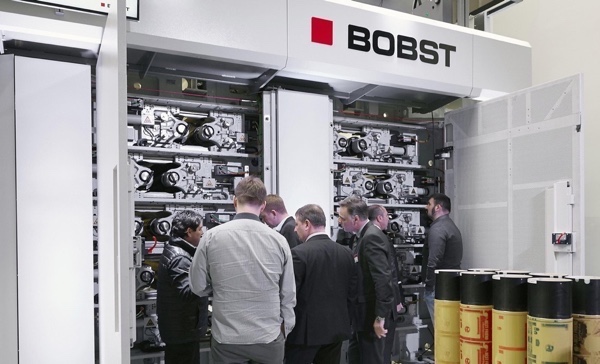Offset Printing
New BOBST 20SEVEN CI flexo press and Extended Color Gamut drive change in the flexible packaging industry

Monday 09. April 2018 - There is no questioning that the use of Extended Color Gamut (ECG) is growing. Although the trend is developing faster for some printing technologies and in some market segments than in others, everyone agrees that a steady growth in the next 10 years is expected. The new 20SEVEN flexo press from BOBST is the companys latest expression of its strategic commitment to deliver ECG solutions for a variety of printing technologies and applications.
“BOBST has been an advocate of the ECG concept since 2013 with the now well-established REVO 7-color Digital Flexo technology developed with leading industry suppliers for narrow and mid-web inline flexo presses,” explained Federico dAnnunzio, Strategic Products Marketing Director, BOBST Business Unit Web-fed. “In 2017, BOBST introduced the THQ FlexoCloud, a fixed color palette solution for corrugated board post print applications. Today, we are tackling wide-web CI flexo printing with the 20SEVEN which offers features that have been specifically developed to deliver best results with ECG printing”.
What are the key factors, market trends and ECG specific requirements considered in the development of the new machine?
“High quality imaging should be consistently repeatable run after run, at high speed, with both solvent-based and water-based inks. The ECG implementation system should be open for use with different printing plates, inks or industry suppliers. The experience of our customers who have implemented the ECG project on other BOBST CI flexo presses like the 20SIX has obviously been invaluable in developing the solution,” said Dieter Betzmeier, R&D Director, Bobst Bielefeld. “From a technical point of view, we addressed the rigidity of the print deck, the ink flow, the drying and the stability of the register.”
To achieve accuracy and consistency, the frame vibrations are eliminated by firmly and accurately locking the print decks bearings. The 20SEVENs bearing bolts are tightened using a pneumatic tool, which applies the same torque, thus avoiding the variables derived from manual operation by different operators. The bearings are precisely kept in place as a result of the triangular geometry of the BOBST triLOCK system.
Ink is another factor that can have a major bearing on process consistency. The BOBST smartFLO system does away with the variables that can have an impact on the uniformity of ink consistency and flow. These include ink variations owing to environmental factors such as temperature and light, change of viscosity due to peaks in the flow from the ink bucket to the substrate and inconsistent ink metering as a result of the ink pumps.
The third fundamental aspect is press drying efficiency. This is even more pronounced with water-based ink printing, which is on the increase in flexible packaging applications. The new FSM (Full Surface Matrix) dryer provides a significantly higher efficiency compared with one-slot drying systems as the blast of air is applied to the substrate over the whole surface of the dryer through hundreds of small jets. This not only guarantees drying at high production speeds, but also enhances register accuracy as the web is evenly pushed against the CI drum.”
In terms of repeatability, the BOBST CI flexo presses rely on the smartGPSTM system. The BOBST offline registration and pressure setting system, in addition to its well-known performance in minimum waste at start up and job changeovers, is also instrumental in increasing the lifetime of high resolution plates by printing the real format, avoiding any distortion of dots.
For a converter, the adoption of the ECG printing process means many sizable economies of time and cost – no more changes of inks and resulting washing of print decks, no need for a huge ink inventory for storing numerous spot inks, no time wasted in ink mixing and a guarantee of color consistency for jobs that are run a long time apart or in different parts of the world. This begs the question why the pace of adoption by the wide-web flexo industry is not as fast as its advantages would suggest?
A converting company with experience in implementing ECG printing is LitoPlas SA. Headquartered in Barranquilla, Colombia, the company has an annual production capacity of 350million sqm of packaging. Luis Mora, Director of Marketing & Innovation at LitoPlas shared the experience of having 50% of their production printed using ECG on two BOBST flexo presses. The engaging presentation at a recent BOBST Open House clearly set out some fundamental principles in terms of challenges and opportunities.
“ECG is a great technology that leverages notable efficiencies and great printing quality. The downside is that its not a plug-and-play technology. To have sustainable benefits, it demands hard work from all the supply chain involved. You need to empower the company´s culture engaging operators around the process philosophy, keep the process in control quantitatively and align customers to the final outcome because the benefits to all of the supply chain are true!” explained Luis Mora.
“The rewards are great, and the advantages that derive from it far offset the disruption of the implementation” commented Danilo Vaskovic, Sales Director, Bobst Bielefeld. “Companies are still hesitant to take a leap that can radically change the core structure of their organization. However, we believe the unstoppable way ahead is about process standardization and process control, in order to eliminate the variables that lead to critical issues, non-conformities and waste in all its forms. ECG makes printing a standardized industrial process, because it cannot afford to be a craft anymore,” he concluded.
